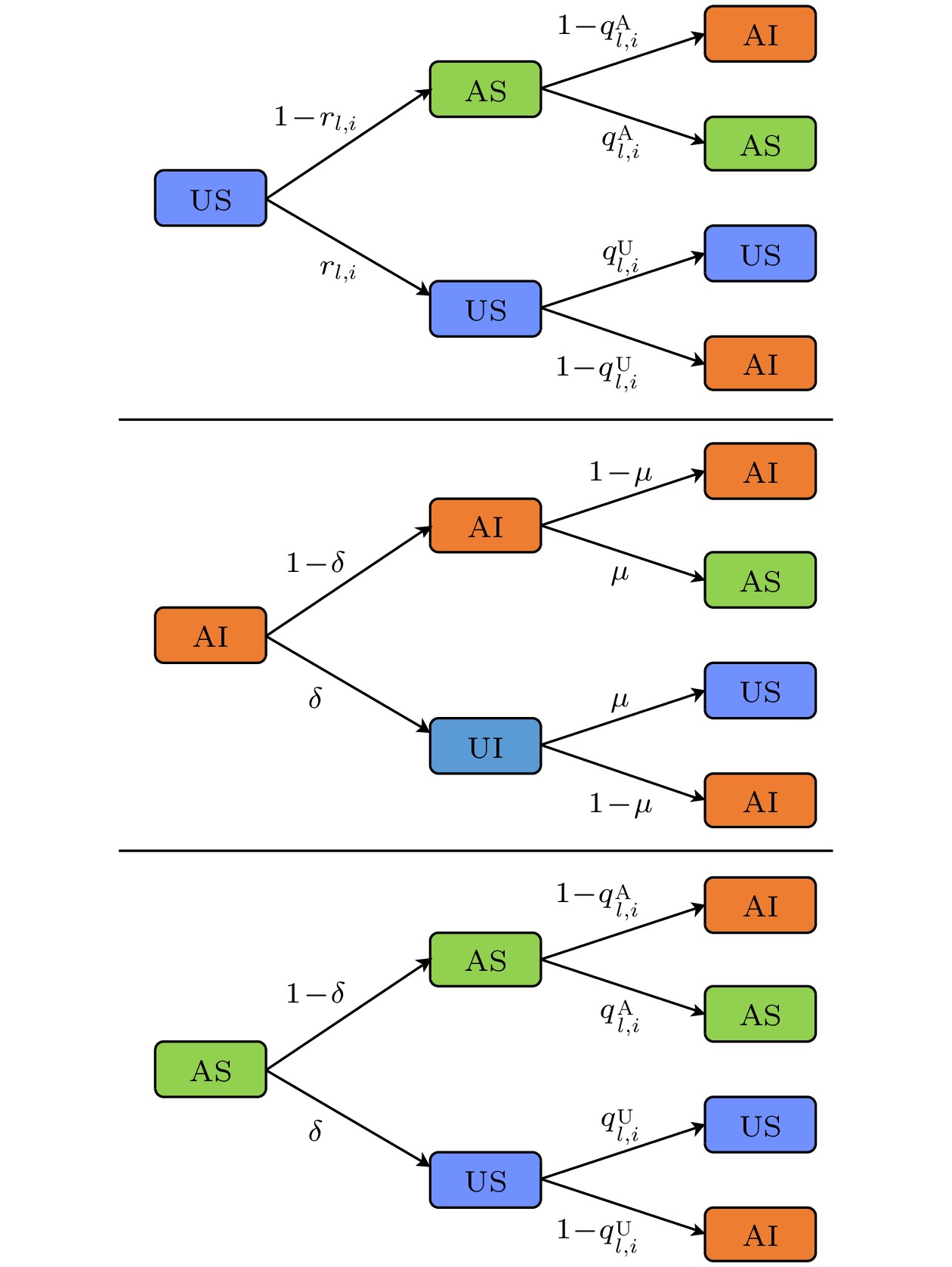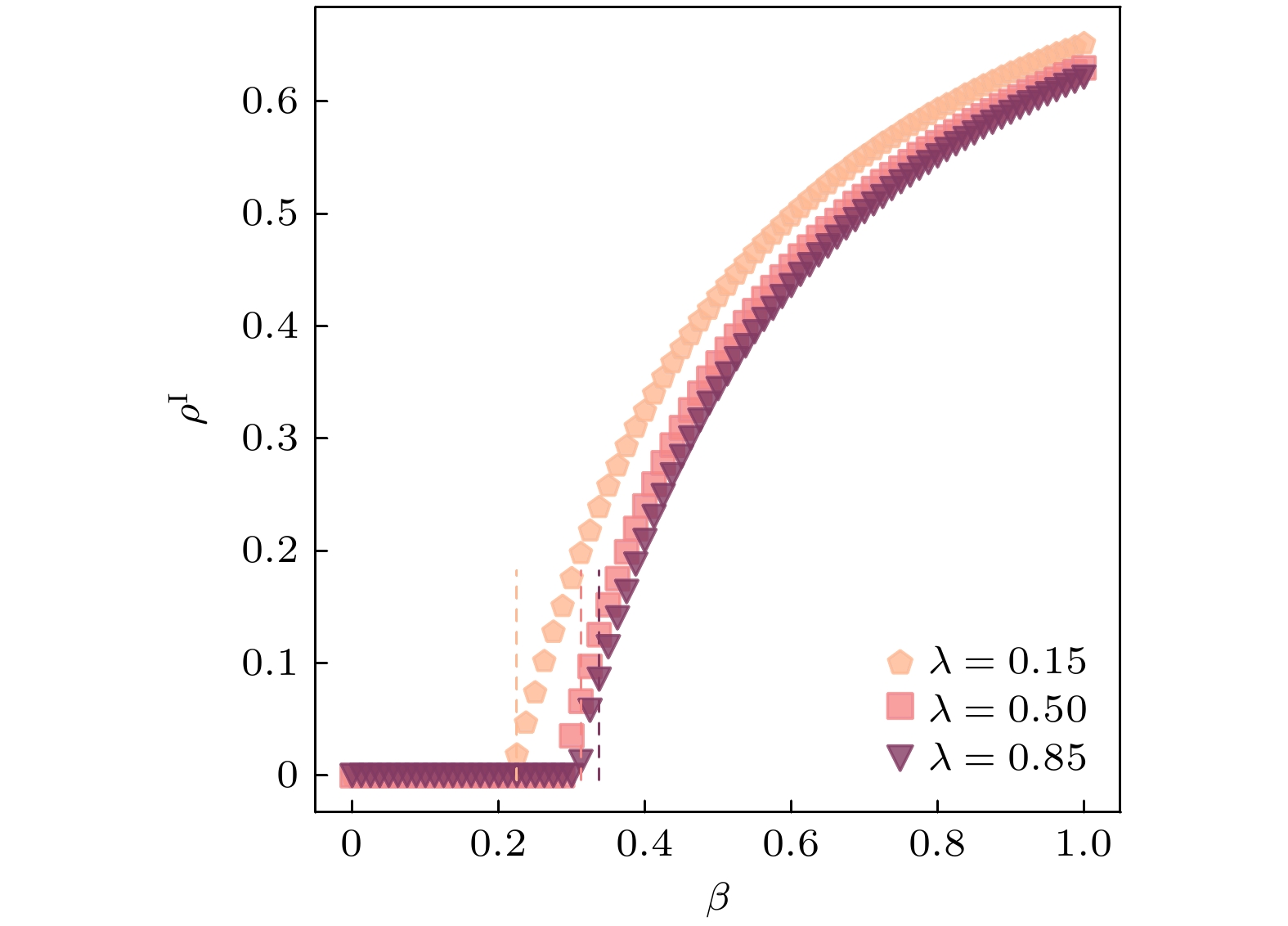-
现实世界中的流行病爆发往往伴随着急剧的信息扩散, 扩散的信息会改变个体行为模式, 反过来又影响流行病传播. 近年来研究发现社交网络中的社团结构对流行病传播也有重要影响. 因此, 考虑结合上述因素来构建一种新的双层网络, 采用活跃性驱动模型生成时变的线上信息接触层网络和线下物理接触层网络, 再利用个体在线上接触层的信息扩散来影响线下物理接触层的流行病传播动态, 以个体流动性因素来控制社团结构特性. 为得到整个网络的传播动力学方程并有效分析网络的传播阈值, 对微观马尔可夫链(micro-scopic Markov chain, MMC)方法进行改进并将其扩展到时变网络. 使用蒙特卡罗(Monte Carlo, MC)模拟进行了实验验证, 显示出所提方法对流行病爆发阈值的预测具有高准确性. 结果表明个体流动性对流行病爆发阈值没有影响, 但会影响每个社团的最终感染人数, 而线上接触层的个体接触能力越大和线下接触层的个体接触能力越小则可以有效抑制流行病传播. 这些发现可对有效防控现实世界中的流行病传播起到重要的参考和借鉴作用.Epidemic outbreaks in the real world are often accompanied by rapid information diffusion, which will change individual behavior patterns and affect the spread of epidemics. The community phenomenon in human society will also have an important influence on the spread of epidemics. The above factors to construct a new bilayer network are considered in this work. The activity-driven model is used to generate time-varying online information contact layer network and offline physical contact layer network. The information diffusion of individual online contact layer is used to affect the epidemic spreading dynamics of offline physical contact layer, and the individual mobility factor is used to control the community structure characteristics. In order to obtain the spreading dynamic equation of the whole network and analyze the spreading threshold of the network effectively, the microscopic Markov chain (MMC) approach is improved and extended to time-varying networks. Experimental verification of Monte Carlo simulations shows that the proposed method is highly accurate in predicting epidemic outbreak thresholds. The results show that individual mobility has no effect on the epidemic outbreak threshold, but it will affect the final number of infections in each community. The greater the individual contact capability of the online contact layer, the smaller the individual contact capability of the offline contact layer that can effectively suppress the epidemic spread. The above findings can present an important reference for effectively preventing and controlling the epidemic transmission in the real world.
-
Keywords:
- microscopic Markov chain approach /
- bilayer network /
- epidemic spreading /
- community structure
[1] 李翔, 李聪, 王建波 2020 复杂网络传播理论-流行的隐秩序(上卷) (北京: 高等教育出版社) 第10页
Li X, Li C, Wang J B 2020 Theory of Spreading on Complex Networks: Hidden Rules of Epidemics (Vol. 1) (Beijing: Higher Education Press) p10 (in Chinese)
[2] Garten R J, Davis C T, Russell C A, et al. 2009 Science 325 197
 Google Scholar
Google Scholar
[3] Machens A, Gesualdo F, Rizzo C, Tozzi A E, Barrat A, Cattuto C 2013 BMC Infect. Dis. 13 185
 Google Scholar
Google Scholar
[4] Park B J, Wannemuehler K A, Marston B J, Govender N, Pappas P G, Chiller T M 2009 AIDS 23 525
 Google Scholar
Google Scholar
[5] Schwarzkopf Y, Rákos A, Mukamel D 2010 Phys. Rev. E 82 036112
 Google Scholar
Google Scholar
[6] Anderson R M, Anderson B, May R M 1992 Infectious Diseases of Humans: Dynamics and Control (Oxford: Oxford University Press) p127
[7] Hethcote H W 2000 SIAM Rev. 42 599
 Google Scholar
Google Scholar
[8] Grabowski A, Kosiński R A 2004 Phys. Rev. E 70 031908
 Google Scholar
Google Scholar
[9] Yang H, Gu C G, Tang M, Cai S M, Lai Y C 2019 Appl. Math. Model. 75 806
 Google Scholar
Google Scholar
[10] Granell C, Gómez S, Arenas A 2013 Phys. Rev. Lett. 111 128701
 Google Scholar
Google Scholar
[11] Davis J T, Perra N, Zhang Q, Moreno Y, Vespignani A 2020 Nat. Phys. 16 590
 Google Scholar
Google Scholar
[12] Wang B, Gou M, Han Y 2021 Nonlinear Dyn. 105 3835
 Google Scholar
Google Scholar
[13] Zhang Q P, Zhong L, Gao S Y, Li X M 2018 IEEE Trans. Cybern. 48 3411
 Google Scholar
Google Scholar
[14] Salehi M, Sharma R, Marzolla M, Magnani M, Siyari P, Montesi D 2015 IEEE Trans. Netw. Sci. Eng. 2 65
 Google Scholar
Google Scholar
[15] Wang B H, Chen W S, Wang J C, Zhang B, Zhang Z Q, Qiu X G 2019 IEEE Trans. Cybern. 49 4308
 Google Scholar
Google Scholar
[16] 孙皓宸, 刘肖凡, 许小可, 吴晔 2020 物理学报 69 240201
 Google Scholar
Google Scholar
Sun H C, Liu X F, Xu X K, Wu Y 2020 Acta Phys. Sin. 69 240201
 Google Scholar
Google Scholar
[17] Wang H, Zhang H F, Zhu P C, Ma C 2022 Chaos 32 083110
 Google Scholar
Google Scholar
[18] Wang W, Liu Q H, Cai S M, Tang M, Braunstein L A, Stanley H E 2016 Sci. Rep. 6 29259
 Google Scholar
Google Scholar
[19] Pan Y H, Yan Z J 2018 Physica A 491 45
 Google Scholar
Google Scholar
[20] Funk S, Gilad E, Watkins C, Jansen V A 2009 Proc. Natl. Acad. Sci. USA 106 6872
 Google Scholar
Google Scholar
[21] Guo Q T, Lei Y J, Jiang X, Ma Y F, Huo G Y, Zheng Z M 2016 Chaos 26 043110
[22] Yang B, Shang K K, Small M, Chao N P 2022 National Science Open 62 254491591
 Google Scholar
Google Scholar
[23] Fortunato S 2010 Phys. Rep. 486 75
 Google Scholar
Google Scholar
[24] 常振超, 陈鸿昶, 刘阳, 于洪涛, 黄瑞阳 2015 物理学报 64 218901
 Google Scholar
Google Scholar
Chang Z C, Chen H C, Liu Y, Yu H T, Huang R Y 2015 Acta Phys. Sin. 64 218901
 Google Scholar
Google Scholar
[25] Huang H, Chen Y, Ma Y 2021 Appl. Math. Comput. 388 125536
[26] Digital 2022: Another Year of Bumper Growth < a href="https://wearesocial.com/cn/blog/2022/01/digital-2022-another-year-of-bumper-growth/">https://wearesocial.com/cn/blog/2022/01/digital-2022-another-year-of-bumper-growth/ [2022-11-17]
[27] Aleta A, Martín-Corral D, Pastore Y Piontti A, et al. 2020 Nat. Hum. Behav. 4 964
 Google Scholar
Google Scholar
[28] Metcalf C J E, Morris D H, Park S W 2020 Science 369 368
 Google Scholar
Google Scholar
[29] Perra N, Gonçalves B 2012 Sci. Rep. 2 469
 Google Scholar
Google Scholar
[30] Mossong J, Hens N, Jit M, et al. 2008 PLOS Med. 5 e74
 Google Scholar
Google Scholar
-
图 5 (a)—(c) 个体接触能力在不同的
$\lambda $ 下对流行病爆发阈值的影响; (d)—(f)线上信息接触层接触能力在不同的$\lambda $ 下对流行病爆发阈值影响的波动率; (g)—(i)线下物理接触层接触能力在不同的$\lambda $ 下对流行病爆发阈值影响的波动率Fig. 5. (a)–(c) Influence of individual contact ability on epidemic outbreak threshold under different conditions; (d)–(f) volatility of the impact on epidemic outbreak thresholds under different virtual network layer contact capabilities; (g)–(i) volatility of impact on epidemic outbreak thresholds for different physical contact layer contact capacities.
表 1 符号的含义
Table 1. Description of all symbols
符号 描述 $N$ 网络中的个体数 $t$ 时间步 ${k_{\text{v}}}$ 线上信息接触层中的活跃个体在单位时间步长中产生的连边数 ${k_{\text{p}}}$ 线下物理接触层中的活跃个体在单位时间步长中产生的连边数 $a_{l, i}^{\text{V}}$ 线上信息接触层中个体i 在$l$社团的活跃性类别 $a_{l, i}^{\text{P}}$ 线下物理接触层中个体i 在$l$社团的活跃性类别 $ \left\langle {{k_{\text{v}}}} \right\rangle $ 线上信息接触层的平均度 $\left\langle {{k_{\text{p}}}} \right\rangle $ 线下物理接触层的平均度 $\lambda $ 信息扩散率 $\delta $ 信息遗忘率 $\beta $ 流行病传染率 $\mu $ 流行病恢复率 ${\beta ^{\text{U}}}$ 状态为U的个体的流行病传染率 ${\beta ^{\text{A}}}$ 状态为A的个体的流行病传染率 $\sigma $ 捕捉${\beta ^{\text{U}}}$和${\beta ^{\text{A}}}$之间差异的参数, 又称为自我保护率: ${\beta ^{\text{A}}} = \sigma {\beta ^{\text{U}}}$ $h$ 个体流动率 $P_{l, i}^X$ 个体i 在$l$社团处于状态X的概率 ${r_{l, i}}\left( t \right)$ 处于$l$社团的个体i 在时间$t$内没有被任何邻居告知的概率 $q_{l, i}^{\text{A}}\left( t \right)$ 处于$l$社团且状态为A的个体i 在时间$t$内没有被任何邻居感染的概率 $q_{l, i}^{\text{U}}\left( t \right)$ 处于$l$社团且状态为U的个体i在时间$t$内没有被任何邻居感染的概率 -
[1] 李翔, 李聪, 王建波 2020 复杂网络传播理论-流行的隐秩序(上卷) (北京: 高等教育出版社) 第10页
Li X, Li C, Wang J B 2020 Theory of Spreading on Complex Networks: Hidden Rules of Epidemics (Vol. 1) (Beijing: Higher Education Press) p10 (in Chinese)
[2] Garten R J, Davis C T, Russell C A, et al. 2009 Science 325 197
 Google Scholar
Google Scholar
[3] Machens A, Gesualdo F, Rizzo C, Tozzi A E, Barrat A, Cattuto C 2013 BMC Infect. Dis. 13 185
 Google Scholar
Google Scholar
[4] Park B J, Wannemuehler K A, Marston B J, Govender N, Pappas P G, Chiller T M 2009 AIDS 23 525
 Google Scholar
Google Scholar
[5] Schwarzkopf Y, Rákos A, Mukamel D 2010 Phys. Rev. E 82 036112
 Google Scholar
Google Scholar
[6] Anderson R M, Anderson B, May R M 1992 Infectious Diseases of Humans: Dynamics and Control (Oxford: Oxford University Press) p127
[7] Hethcote H W 2000 SIAM Rev. 42 599
 Google Scholar
Google Scholar
[8] Grabowski A, Kosiński R A 2004 Phys. Rev. E 70 031908
 Google Scholar
Google Scholar
[9] Yang H, Gu C G, Tang M, Cai S M, Lai Y C 2019 Appl. Math. Model. 75 806
 Google Scholar
Google Scholar
[10] Granell C, Gómez S, Arenas A 2013 Phys. Rev. Lett. 111 128701
 Google Scholar
Google Scholar
[11] Davis J T, Perra N, Zhang Q, Moreno Y, Vespignani A 2020 Nat. Phys. 16 590
 Google Scholar
Google Scholar
[12] Wang B, Gou M, Han Y 2021 Nonlinear Dyn. 105 3835
 Google Scholar
Google Scholar
[13] Zhang Q P, Zhong L, Gao S Y, Li X M 2018 IEEE Trans. Cybern. 48 3411
 Google Scholar
Google Scholar
[14] Salehi M, Sharma R, Marzolla M, Magnani M, Siyari P, Montesi D 2015 IEEE Trans. Netw. Sci. Eng. 2 65
 Google Scholar
Google Scholar
[15] Wang B H, Chen W S, Wang J C, Zhang B, Zhang Z Q, Qiu X G 2019 IEEE Trans. Cybern. 49 4308
 Google Scholar
Google Scholar
[16] 孙皓宸, 刘肖凡, 许小可, 吴晔 2020 物理学报 69 240201
 Google Scholar
Google Scholar
Sun H C, Liu X F, Xu X K, Wu Y 2020 Acta Phys. Sin. 69 240201
 Google Scholar
Google Scholar
[17] Wang H, Zhang H F, Zhu P C, Ma C 2022 Chaos 32 083110
 Google Scholar
Google Scholar
[18] Wang W, Liu Q H, Cai S M, Tang M, Braunstein L A, Stanley H E 2016 Sci. Rep. 6 29259
 Google Scholar
Google Scholar
[19] Pan Y H, Yan Z J 2018 Physica A 491 45
 Google Scholar
Google Scholar
[20] Funk S, Gilad E, Watkins C, Jansen V A 2009 Proc. Natl. Acad. Sci. USA 106 6872
 Google Scholar
Google Scholar
[21] Guo Q T, Lei Y J, Jiang X, Ma Y F, Huo G Y, Zheng Z M 2016 Chaos 26 043110
[22] Yang B, Shang K K, Small M, Chao N P 2022 National Science Open 62 254491591
 Google Scholar
Google Scholar
[23] Fortunato S 2010 Phys. Rep. 486 75
 Google Scholar
Google Scholar
[24] 常振超, 陈鸿昶, 刘阳, 于洪涛, 黄瑞阳 2015 物理学报 64 218901
 Google Scholar
Google Scholar
Chang Z C, Chen H C, Liu Y, Yu H T, Huang R Y 2015 Acta Phys. Sin. 64 218901
 Google Scholar
Google Scholar
[25] Huang H, Chen Y, Ma Y 2021 Appl. Math. Comput. 388 125536
[26] Digital 2022: Another Year of Bumper Growth < a href="https://wearesocial.com/cn/blog/2022/01/digital-2022-another-year-of-bumper-growth/">https://wearesocial.com/cn/blog/2022/01/digital-2022-another-year-of-bumper-growth/ [2022-11-17]
[27] Aleta A, Martín-Corral D, Pastore Y Piontti A, et al. 2020 Nat. Hum. Behav. 4 964
 Google Scholar
Google Scholar
[28] Metcalf C J E, Morris D H, Park S W 2020 Science 369 368
 Google Scholar
Google Scholar
[29] Perra N, Gonçalves B 2012 Sci. Rep. 2 469
 Google Scholar
Google Scholar
[30] Mossong J, Hens N, Jit M, et al. 2008 PLOS Med. 5 e74
 Google Scholar
Google Scholar
计量
- 文章访问数: 9176
- PDF下载量: 184
- 被引次数: 0














 下载:
下载:











